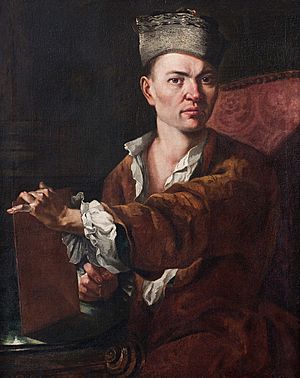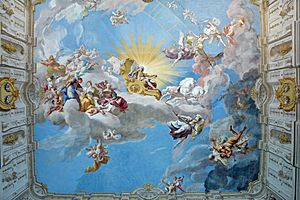Paul Troger facts for kids
Quick facts for kids
Paul Troger
|
|
|---|---|

Self portrait at the age of 30
|
|
| Born | 30 October 1698 Welsberg, Tyrol
|
| Died | 20 July 1762 (aged 63) |
| Nationality | Austrian |
| Education | Giuseppe Alberti, Sebastiano Ricci and Francesco Solimena |
| Known for | Painting |
|
Notable work
|
Frescoes in Altenburg, Melk and Göttweig Abbeys |
| Movement | Baroque |
Paul Troger (born October 30, 1698 – died July 20, 1762) was a famous Austrian artist. He was a painter, a draughtsman (someone who draws), and a printmaker. He lived during the late Baroque period, which was a time of grand and dramatic art.
Troger was best known for his amazing ceiling paintings called frescoes. These paintings looked like they had depth and movement, almost as if they were real scenes happening above you! He used bright, light colors, which made his art feel very lively.
His unique style, especially in his frescoes, was very important in Austria. It shaped Austrian painting for many years and inspired many other artists who came after him. Some of these artists include Franz Anton Maulbertsch and Josef Ignaz Mildorfer.
Contents
Paul Troger's Life
Paul Troger was born on October 30, 1698, in a place called Welsberg in Tyrol. When he was 16, a rich family helped him travel to Fiume. There, he became a student of an artist named Giuseppe Alberti.
His first fresco painting was called “Three Angels with the Cross and Putti.” He painted it in a church in Kaltern in 1722.
Studying Art in Italy
In 1722, a church leader sent Paul Troger to Venice, Italy. In Venice, he saw the artworks of famous painters like Giovanni Battista Piazzetta. Troger also studied in other important art cities in Italy. He learned from Sebastiano Ricci in Rome and Francesco Solimena in Naples. He also studied in Bologna.
Working in Austria
After his studies in Italy, Troger returned to Austria. He first worked in Salzburg from 1726 to 1728. He painted a large fresco called "Glory of Saint Cajetan" on a church ceiling there.
Later, he moved to Vienna. At that time, other artists like Johann Michael Rottmayr were very popular for ceiling frescoes. But Paul Troger soon became a favorite.
He worked a lot with an architect named Josef Munggenast. Together, they created many frescoes in monasteries in Lower Austria.
Becoming a Professor
In 1753, Paul Troger joined the Imperial Academy of Fine Arts. This was a very important art school. He became a professor there and was made the director in 1754. One of his most famous students was Franz Anton Maulbertsch.
Troger made a big change in Austrian painting. Before him, many artists used dark colors. But Troger started using much lighter colors. This new style became popular and fit the new Rococo art taste.
Paul Troger's Works
Paul Troger created many paintings for altars and also made many drawings. But he became most famous for his frescoes. Frescoes are paintings done on wet plaster walls or ceilings. His frescoes were in high demand all over Austria.
Troger's frescoes are known for their lively movement and bright colors. Here are some of his most important ceiling paintings:
- Frescoes in the Church of the Englische Fräulein in St. Pölten (1729/1730).
- Frescoes in large monasteries across Austria:
- In Melk Abbey, he painted the Marble Hall and the library (1732–1733).
- At Göttweig Abbey, he painted the "Apotheosis of Charles VI" (a scene showing a person becoming a god) over the main stairway (1739).
- For Altenburg Abbey, he painted the church, stairwell, and library (1732–1734).
- He also painted at Zwettl Abbey (1733).
- At Seitenstetten Abbey, he painted the Marble hall (1735) and the library (1740).
- And at Geras Abbey, he painted the Marble hall (1738).
- Frescoes for the church of nuns in Bratislava (1740s).
- "Apotheosis of Saint Ignatius" in St. Ignatius’ church in Győr, Hungary (1744; 1747).
- "Adoration of the Lamb" in Brixen Cathedral, Italy (1748–1750).
- Vision of St. Ulrich at the Battle of Lechfeld, for the main altar in St Ulrich, Vienna (1750).
- The dome of the pilgrimage church of Maria Dreieichen near Vienna (1752).
See also
 In Spanish: Paul Troger para niños
In Spanish: Paul Troger para niños



